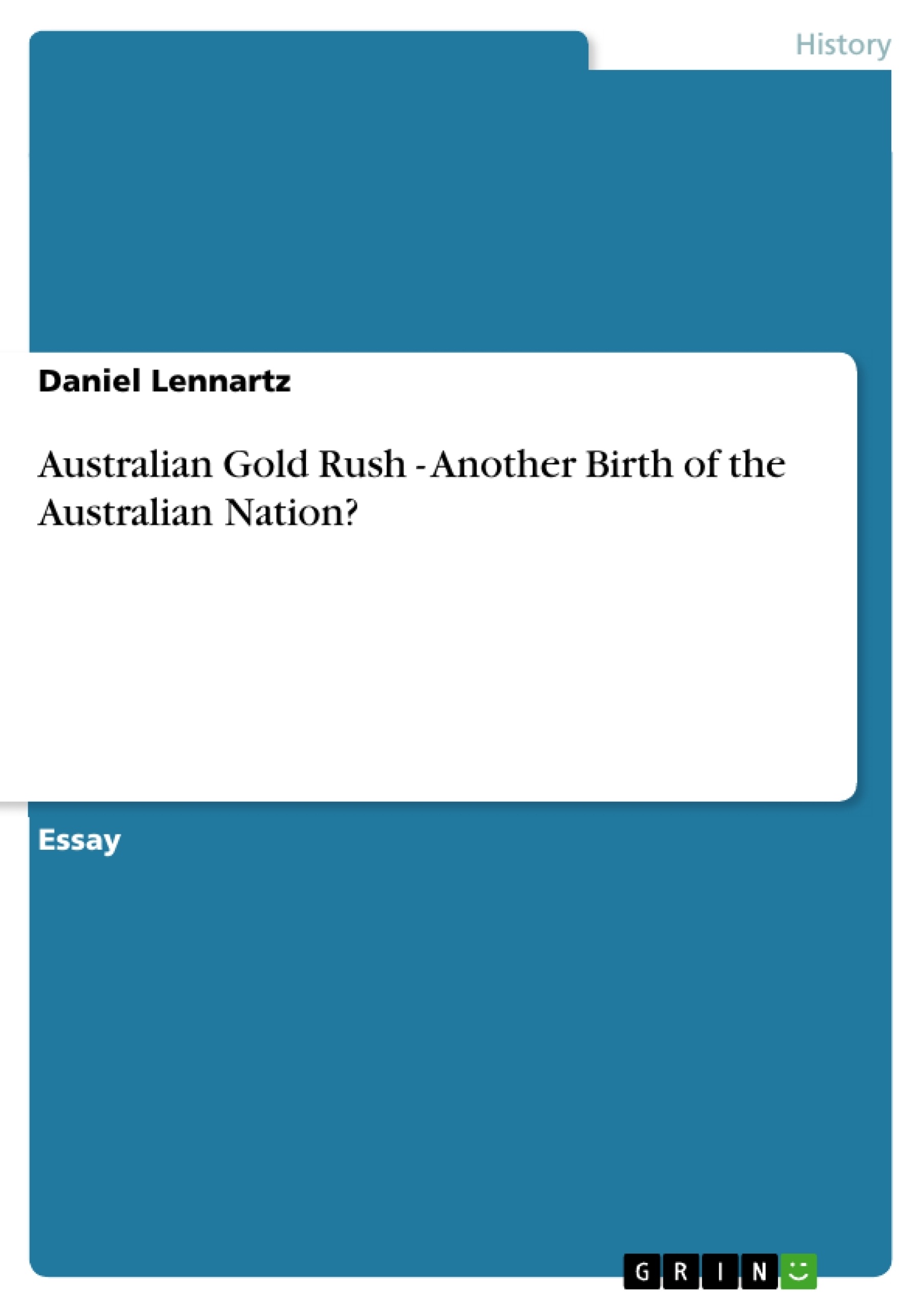This essay deals with the ‘Gold Rush' in Australia at the middle of the 19th century, which nowadays, according the public opinion, belongs to the nation’s folklore, and pursue the question how the history of Australia has been influenced by this ‘Gold Rush’. Those effects of the gold fever are divided into three aspects which are intertwined with each other: population balance, law and an emerging national identity. It shall be shown how these three issues are caused by the discovery of gold and are mutually dependent.
This essay deals with the ‘Gold Rush' in Australia at the middle of the 19th century, which nowadays, according the public opinion, belongs to the nation’s folklore, and pursue the question how the history of Australia has been influenced by this ‘Gold Rush’. Those effects of the gold fever are divided into three aspects which are intertwined with each other: population balance, law and an emerging national identity. It shall be shown how these three issues are caused by the discovery of gold and are mutually dependent.
Population
When in 1851 Edward Hargraves discovered gold nearby Bathurst in New South Wales, it was not to be foreseen which results this should have for Australia. This occasion mark the beginning of the Gold Rush which included Victoria 6 months later. By the fact that Victoria put out two thirds of the worldwide golden yield in 1852 it is underlined as considerably the discovery must have been and can be looked as a reason about the mass migration starting on it which increased Victoria’s population by around 700 per cent within ten years. But there had also been migration within the Australian borders. A lot of Australians left New South Wales, South Australia and Van Diemen’s Land in order to find their fortune on the goldfields. The economies of latter colonies suffered most from their loss of population with the result that their agriculture collapsed as settlers and their labourers headed for the goldfields[1]. Other phenomena are on the one hand canvas towns which accommodated a large number of immigrants and on the other hand deserted towns and suburbs whose population also moved to the goldfields[2]. So ‘the greatest impact of Australia’s first gold rushes was, arguably, the demographic shock which it applied to the colony of Victoria’, which was moreover significant, apart from the tremendous population growth itself, because of the afore British shaped ethnic composition of the country which had been shifted.[3] Among the 572,661 immigrants by sea significant numbers came from Germany, the United States and China whereas the latter made about one quarter of all miners. ‘In 1861, Chinese immigrants made up 3.3 per cent of the Australian population, the greatest it has ever been‘.[4] Increasingly multicultural goldfields corresponded with clichés, prejudices and resentments against non-British immigrants, but in particular against the Chinese. ‘The Lambing Flat Riots’ embody the inglorious peak of the prejudices and campaigns to oust the Chinese from the goldfields.
Both immigration und national migrations were complemented by a distinctive Australian family structure which led to a natural increase in the 1860s. This traces back to the fact that, firstly the government sponsored the immigration of single women, secondly the marriage rate among settlers was almost 100 per cent and last but not least these marriages produced large families.[5]
Law Reforms
Even before in 1851 in New South Wales gold was discovered, Australia already underwent important political changes. Till the Australian Constitutions Act passed the British Parliament in 1850 in New South Wales there had been a partially representative legislative council because of the Legislation Act in 1842. This council had 36 members of whom 24 members were elected by the people and the remaining 12 members were appointed by the Crown. Although the Act of 1842 was a step toward self-government the eligibility to vote based on ownership or occupation of property and the Governor still had more power than the council because of the Governor’s right to reject bills proposed by the Council.[6]
The Australian Constitution Act in 1850 shaped radically the political landscape of Australia. The Act empowered the Legislative Council in New South Wales and granted representative government to South Australia, Van Diemen’s Land and Victoria, which was separated from New South Wales. Furthermore it allowed the establishment of two houses of parliament und liberalised franchise for legislative councils whereas for the latter issue Van Diemen’s Land and Western Australia were excluded.[7] In view of this political change, of the gold discovery and of the tremendous population growth the following political effect of the Gold Rush must be looked at.
[...]
[1] Fahey, Charles 2008, p. 207
[2] Hoban, Suzie, ‘The Immigration Rush’
[3] Fahey, Charles 2008, p. 207
[4] Australia’s Culture Portal
[5] Fahey, Charles 2008, p. 209
[6] Grant, Nicole, ‘Law and Government in the 1850s’
[7] Ganter, R. 2008, lecture notes Australian History, Faculty of Arts, Griffith University, 8th September.
- Citar trabajo
- Daniel Lennartz (Autor), 2008, Australian Gold Rush - Another Birth of the Australian Nation?, Múnich, GRIN Verlag, https://www.grin.com/document/138864
-

-

-

-
¡Carge sus propios textos! Gane dinero y un iPhone X. -

-
¡Carge sus propios textos! Gane dinero y un iPhone X. -

-
¡Carge sus propios textos! Gane dinero y un iPhone X. -

-
¡Carge sus propios textos! Gane dinero y un iPhone X. -

-
¡Carge sus propios textos! Gane dinero y un iPhone X.

